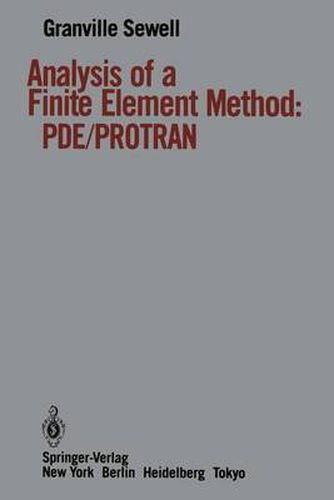Readings Newsletter
Become a Readings Member to make your shopping experience even easier.
Sign in or sign up for free!
You’re not far away from qualifying for FREE standard shipping within Australia
You’ve qualified for FREE standard shipping within Australia
The cart is loading…






This title is printed to order. This book may have been self-published. If so, we cannot guarantee the quality of the content. In the main most books will have gone through the editing process however some may not. We therefore suggest that you be aware of this before ordering this book. If in doubt check either the author or publisher’s details as we are unable to accept any returns unless they are faulty. Please contact us if you have any questions.
This text can be used for two quite different purposes. It can be used as a reference book for the PDElPROTRAN user* who wishes to know more about the methods employed by PDE/PROTRAN Edition 1 (or its predecessor, TWODEPEP) in solving two-dimensional partial differential equations. However, because PDE/PROTRAN solves such a wide class of problems, an outline of the algorithms contained in PDElPROTRAN is also quite suitable as a text for an introductory graduate level finite element course. Algorithms which solve elliptic, parabolic, hyperbolic, and eigenvalue partial differential equation problems are pre sented, as are techniques appropriate for treatment of singularities, curved boundaries, nonsymmetric and nonlinear problems, and systems of PDEs. Direct and iterative linear equation solvers are studied. Although the text emphasizes those algorithms which are actually implemented in PDEI PROTRAN, and does not discuss in detail one- and three-dimensional problems, or collocation and least squares finite element methods, for example, many of the most commonly used techniques are studied in detail. Algorithms applicable to general problems are naturally emphasized, and not special purpose algorithms which may be more efficient for specialized problems, such as Laplace’s equation. It can be argued, however, that the student will better understand the finite element method after seeing the details of one successful implementation than after seeing a broad overview of the many types of elements, linear equation solvers, and other options in existence.
$9.00 standard shipping within Australia
FREE standard shipping within Australia for orders over $100.00
Express & International shipping calculated at checkout
This title is printed to order. This book may have been self-published. If so, we cannot guarantee the quality of the content. In the main most books will have gone through the editing process however some may not. We therefore suggest that you be aware of this before ordering this book. If in doubt check either the author or publisher’s details as we are unable to accept any returns unless they are faulty. Please contact us if you have any questions.
This text can be used for two quite different purposes. It can be used as a reference book for the PDElPROTRAN user* who wishes to know more about the methods employed by PDE/PROTRAN Edition 1 (or its predecessor, TWODEPEP) in solving two-dimensional partial differential equations. However, because PDE/PROTRAN solves such a wide class of problems, an outline of the algorithms contained in PDElPROTRAN is also quite suitable as a text for an introductory graduate level finite element course. Algorithms which solve elliptic, parabolic, hyperbolic, and eigenvalue partial differential equation problems are pre sented, as are techniques appropriate for treatment of singularities, curved boundaries, nonsymmetric and nonlinear problems, and systems of PDEs. Direct and iterative linear equation solvers are studied. Although the text emphasizes those algorithms which are actually implemented in PDEI PROTRAN, and does not discuss in detail one- and three-dimensional problems, or collocation and least squares finite element methods, for example, many of the most commonly used techniques are studied in detail. Algorithms applicable to general problems are naturally emphasized, and not special purpose algorithms which may be more efficient for specialized problems, such as Laplace’s equation. It can be argued, however, that the student will better understand the finite element method after seeing the details of one successful implementation than after seeing a broad overview of the many types of elements, linear equation solvers, and other options in existence.